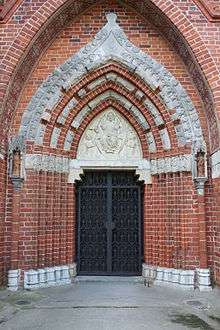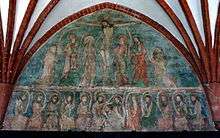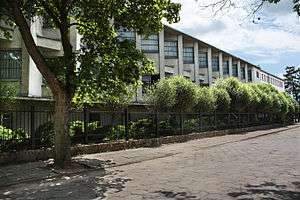Pelplin
Pelplin (pronounced [ˈpɛlplʲin]; Kashubian: Pôłplëno) is a town in northern Poland, in the Tczew County, Pomeranian Voivodship. Population: 8,320 (2009).
Pelplin | |
|---|---|
  .jpg) .jpg)
| |
 Flag  Coat of arms | |
 Pelplin | |
| Coordinates: 53°55′41″N 18°41′52″E | |
| Country | |
| Voivodeship | Pomeranian |
| County | Tczew |
| Gmina | Pelplin |
| Government | |
| • Mayor | Andrzej Stanuch |
| Area | |
| • Total | 4.45 km2 (1.72 sq mi) |
| Population (2009) | |
| • Total | 8,320 |
| • Density | 1,900/km2 (4,800/sq mi) |
| Postal code | 83-130 |
| Website | http://www.pelplin.pl |
Pelplin is located in the ethnocultural region of Kociewie in Pomerania. It is home to one of the finest collections of medieval art in Poland held at the Diocesan Museum in Pelplin[1]. It is known for the landmark Gothic Pelplin Cathedral, former abbey church, one of the largest Gothic churches in Poland. The former Pelplin Abbey is the seat of the Roman Catholic Diocese of Pelplin.
Geographical location
Pelplin lies in a valley on both sides of river Wierzyca, a left affluent of river Vistula in Pomeralia, which ends up in the Vistula at the town of Gniew. Pelplin is located about 11 kilometres (7 miles) west of the Vistula, 12 km (7 miles) south-east of the town of Starogard Gdański, 19 km (12 miles) south-west the town of Tczew and 50 km (31 miles) south of the regional capitol of Gdańsk. It is surrounded by a chain of little hills, its altitude varies between 8 metres (26 feet) above sea level at the lowlands of the Vistula in the east and 86 metres (282 feet) above sea level at 'Czubatka' hill in the west.
History
Archaeological findings have revealed that human settlements existed in the region of the town already during the Stone Age and the Bronze Age.
The history of Pelplin is tightly interwoven with the history of the Monastery of Pelplin, which according to the monastery's chronicle was founded in 1274 by Mestwin II, Duke of Pomerania. The monastery of Pelplin had a forerunner in the monastery of the Cistercians in Pogutken located at the upper course of the Wierzyca, which had been founded in 1258 by Sambor II, Duke of Pomerania. In 1276 the monks, which had come from the Monastery of Doberan in Mecklenburg to Pogutken, begun to transfer their monastery to Pelplin.
From Pelplin, the German monks organized an extensive settlement campaign. They brought in dispossessed farmers and craftsmen and founded a number of German villages in the area. The initiative came from Duke Sambor II, who wanted to compensate population losses of the past, which had occurred because of wars with Pomeralia's neighbours, the Kingdom of Poland in the south and the Old Prussians in the east. During the 12th century, Polish dukes gained control over Pomeralia.
_03.jpg)


The monks also begun to build an impressive Gothic cathedral, now the Pelplin Abbey, using mainly bricks as construction material. According to the monastery's chronicle, work on the building was taken up already prior to 1294 by Mestwin II, Duke of Pomerania, and was completed during the second half of the 14th century, amounting to a building time of almost 200 years. The monastery was attached to the southern side of the cathedral. It was enlarged considerably during subsequent centuries. The cathedral of the Cistercians, now Pelplin Abbey, is recognized as one of the most important examples of sacral architecture in the Vistula region.
As far as matters concerning the church were concerned, the region of Pelplin was at that time subordinated to the administration of the Diocese of Gniezno.
Pelplin was part of the Duchy of Pomerania (Eastern/Gdańsk Pomerania), which in 1227 separated from Poland as a result of the fragmentation of the state. In 1282, Duke Mestwin II and Polish Duke Przemysł II (future King of Poland) signed the Treaty of Kępno, which transferred the suzerainty over Gdańsk Pomerania including Pelplin to Przemysł II and, subsequently, after Mestwin II's death in 1294, Pelplin was reintegrated with Poland. In 1310 the Teutonic Order captured Gdańsk Pomerania and incorporated it into the monastic State of the Teutonic Order. In 1466, after the Second Peace of Thorn, the region was reincorporated into the Kingdom of Poland. Pelplin was since part of the Pomeranian Voivodeship in the autonomous province of Royal Prussia. In the following centuries several Polish Kings visited the Pelplin Abbey, among them Sigismund III Vasa and John III Sobieski. During the reformation, the last abbot of the monastery of Doberan moved in 1552 to the affiliated monastery of Pelplin.
Partitions of Poland
In 1772, during the First Partition of Poland by the Russian, Austrian and the Prussian empires, Gdańsk Pomerania was annexed into the Kingdom of Prussia (as the new German province of West Prussia), and the religious and political discrimination of the Poles greatly intensified.[2]
In 1819 the Pelplin monastery was suppressed. After the monastic buildings had been modified, they were utilized since 1824 as the seat of the Bishopric of Culm, which was moved to Pelplin. By that time Pelplin had remained a small village with several pubs. Since 1824 it begun to develop rapidly due to the accommodation of a number of ecclesiastical and clerical institutions. In 1238 a training school for priests was founded, and since 1835 there existed also the Collegium Marianum, an episcopal Progymnasium.
The economical development of Pelplin accelerated after 1852, when the village was connected to the new railway line Bydgoszcz—Gdańsk (Bromberg—Danzig). In 1905 there existed in addition a supreme forestry superintendent's office, an engineering-works and a sugar factory.[3] Up to 1920 Pelplin belonged to Kreis Dirschau in the administrative district of Regierungsbezirk Danzig in West Prussia.
Return to independence
After World War I as a consequence of Treaty of Versailles the so-called Polish Corridor was created, and Pelplin was integrated into the Second Republic of Poland. In 1925 the bishopric of Chełmno (Culm) was renamed as bishopric of Pelplin. In 1931, Pelplin received city rights. In 1939, after the Nazi invasion of Poland, Gdańsk Pomerania was annexed by the German Third Reich and incorporated into the newly formed province of Reichsgau Danzig-West Prussia. During World War II Pelplin was captured by the Red Army. After the end of war Pelplin became part of People's Republic of Poland
Gmina Pelplin
The Gmina Pelplin is based on the historical administrative rural district of Pelplin, which existed prior to 1920. In 1789 the district consisted of three leased farm estates, nine fee-farm type of settlements and of 18 villages and other smaller settlements, comprising all together 602 households. During the aera of the Third Reich some villages were given different German names.
Notable people
- Andrzej Liss (born 1950 in Pelplin) a Polish politician, elected to the Sejm in 2005
Footnotes
- Diocesan Museum in Pelplin. Homepage.
- Encyclopædia Britannica Online (2008), Poland. History > The Commonwealth > Reforms, agony, and partitions. The First 1772 Partition.
- Meyers Großes Konversations-Lexikon,6th edition, Vol. 15, Leipzig and Vienna 1908, p. 554.
External links
| Wikimedia Commons has media related to Pelplin. |
- Official Website of the Community (multi-linguistic)
